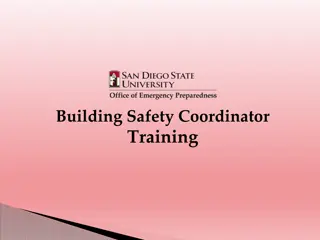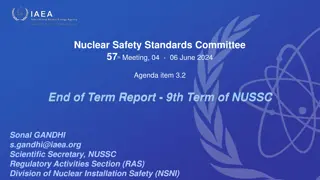Supervisor Success Series Safety Module
Safety training module at Michigan Tech University focuses on equipping supervisors with safety responsibilities, resources, employee training, task evaluation, and leadership skills. The training emphasizes the importance of safety, OSHA/MIOSHA regulations, and fostering a strong safety culture. Interactive activities and discussions engage participants in identifying and addressing safety challenges, promoting a safe and secure campus environment.
Download Presentation

Please find below an Image/Link to download the presentation.
The content on the website is provided AS IS for your information and personal use only. It may not be sold, licensed, or shared on other websites without obtaining consent from the author.If you encounter any issues during the download, it is possible that the publisher has removed the file from their server.
You are allowed to download the files provided on this website for personal or commercial use, subject to the condition that they are used lawfully. All files are the property of their respective owners.
The content on the website is provided AS IS for your information and personal use only. It may not be sold, licensed, or shared on other websites without obtaining consent from the author.
E N D
Presentation Transcript
Supervisor Success Series Safety Module Photo Credit: Sarah Bird
Welcome ! Fire exits In case of fire, please walk to the nearest exit Unsafe act or condition If you see an unsafe act or condition, please notify the instructor
Safety Module Road Map Introduction Safety @ Michigan Tech Occupational Safety Job Hazard Analysis Personal Protective Equipment (PPE) and Training Incident Reporting Supervisor Safety Responsibilities 4 Point Wrap-up
Presenter Chris Maxson Safety Specialist s Shane (Sully) Sullivan Manager of Merchandising Operations Scott Wendt Manager of Health and Safety
What is the Goal of this Training? To equip MTU supervisors with: 1. Safety responsibilities 2. Safety resources 3. Employee training 4. Evaluation of employee tasks 5. How to be effective Safety Leaders as part of their supervisory responsibilities.
Break-Out Activity What is the most Challenging to you about Safety? 2-3 min: Write down two or three Items. Choose the Biggest Challenge. 5 min: Everyone Share Biggest Challenge. Vote (2 Votes per person) to determine Biggest Challenge. Brief Discussion as to why Biggest Challenge rose to #1 Position
Why Safety is Important? Huskies commit to: Shared Values: A safe and secure campus environment A workplace where employees can be productive Preventing work-related injuries and illnesses And there are rules too
Safety Module Road Map Introduction Safety @ Michigan Tech Occupational Safety Job Hazard Analysis Personal Protective Equipment (PPE) and Training Incident Reporting Supervisor Safety Responsibilities 4 Point Wrap-up
MTU Safety Culture Safety culture is not exact, but a collection of attitudes and practices related to the commitment, type and effectiveness of health and safety matters. How we do things around here .
Safety @ Michigan Tech Departments Public Safety and Police Services Environmental Health and Safety Research Integrity Risk Management Michigan Tech EMS
Safety @ Michigan Tech Committees / Councils President s Council on Health and Well-being University Safety Advisory Council MTU Flex Team College of Engineering Safety Committee Radiation Safety Committee Bio-Safety Committee Mine Safety and Health Numerous Departmental Safety Committees
Safety Module Road Map Introduction Safety @ Michigan Tech Occupational Safety Job Hazard Analysis Personal Protective Equipment (PPE) and Training Incident Reporting Supervisor Safety Responsibilities 4 Point Wrap-up
What are your Responsibilities as a Supervisor? Supervisors are directly responsible and accountable for carrying out occupational health and safety regulations, and university safety procedures within their area of control
Supervisor Safety Responsibilities Include: Making a reasonable effort to ensure the safety of employees and students in the area of your control Evaluating physical capabilities of employees to perform tasks Promoting safe attitudes and practices Enforcing safe work practices Responding appropriately to employee safety concerns Completing all the same safety trainings required for your employees, so you know whether they are complying, and so you can answer their questions.
Supervisor Safety Responsibilities continued: Providing job training on work area safety procedures for all employees, especially new hires and reassigned employees Supervisors must ensure their employees or students receive all required safety training Supervisors must provide on the job training specific to their location/activities All training must be documented
Supervisors are the Front-Line Safety Leaders Supervisors represent MTU as the employer in Standards
Supervisor Safety Responsibilities continued: Conducting regular work area safety inspections with the guidance of EHS/RIO to identify and correct unsafe conditions and work practices Providing proper equipment so employees can perform their jobs safely including tools and personal protective equipment, as well as procedures and training for safe operation.
Supervisor Safety Responsibilities continued: Investigating injury accidents utilizing lean techniques (i.e. root cause analysis) to determine cause, correct safety deficiencies, and prevent reoccurrence. Reporting accidents immediately
So who are you responsible for? An Employee is anyone receiving monetary compensation to perform a duty at MTU Faculty Staff Student Employees Graduate Assistants Keep in mind that you may supervise non-employees (volunteers, visiting or adjunct professors, etc). Their safety is equally important and safety rules and regulations apply to them as well, particularly safety training requirements. Temporary Workers
Break-Out Activity Re-evaluate Challenges to you about Supervisory Safety? 5 min: Group Discussion on previous exercise results. Any Changes? Additions? Reevaluate order?
It can feel overwhelming beyond confusing and pretty much impossible . But Don t Worry MTU ENVIRONMENTAL HEALTH & SAFETY is always here to help!
MTU Environmental Health & Safety Deals with all aspects of health and safety in the workplace with a strong focus on primary prevention of hazards on campus Our goal is to prevent accidents and harm to employees from work- related activities
Most Standards start with OSHA Occupational Safety and Health Administration But some states have their Jurisdictions
Michigan is one of them Michigan Occupational Safety and Health Administration (MIOSHA) MIOSHA Standards are as stringent or more stringent than federal requirements
MTU EHS assists with: Training Inspections Hazard Assessment Accident Review Environmental Monitoring Safety Program Development
MTU EHS assists with: EHS is responsible for promoting and ensuring MTU compliance with environmental and occupational safety and health requirements EHS helps groups and departments identify rules, regulations, policies, and procedures that affect operations
OSHA/MIOSHA Required Programs Right to Know / Hazard Communication Lockout-Tagout PPE Assessment Respiratory Protection Permit-Required Confined Space Emergency Evacuation Plan Bloodborne Infectious Diseases Hearing Conservation Program Construction- Accident Prevention Program
Safety Module Road Map Introduction Safety @ Michigan Tech Occupational Safety Job Hazard Analysis Personal Protective Equipment (PPE) and Training Incident Reporting Supervisor Safety Responsibilities 4 Point Wrap-up
Break-Out Activity How to Plant a Tree Scenario . 5 min: Break into groups. Scenario: You have been instructed to plant this tree. You have been provided all the tools necessary. List the steps to safely complete this task. Share and discuss steps. Are there any Hazards you can identify?
Hazard Identification Hazard Identification is the foundation of a safe workplace. At its most basic level, hazard identification is simply looking at a job, task or a situation and asking, Is there anything here that could hurt someone or damage something?
Hazard Identification What is a workplace hazard? A workplace hazard is ANY practice, behavior or physical condition that has the potential to cause: Injury Illness Damage to property Damage to the environment Loss to a process .
Hazard Identification There are hazards in EVERY type of job and EVERY type of workplace! Everyone at MTU: Workers, Supervisors and EHS, share in the responsibility to identify and control hazards A Hazard cannot be controlled (i.e. eliminated, reduced, or otherwise managed) until it has been identified !
Hazard Identification Tool There are many standard hazard identification tools that can help to document the hazard identification and control processes Job Hazard Analysis, often referred to as a Job Safety Analysis (JSA), is an important accident prevention tool that works by identifying existing and/or potential hazards associated with a particular job
Hazard Identification Tool Job Hazard Assessment (JHA) A JHA works by finding hazards and eliminating or minimizing them before the job is performed and before the employee has a chance to become injured. JHA are used for : Job clarification Hazard awareness To guide in new employee training Retraining of employees, Refresher for infrequent tasks, Accident investigation tool Informing employees of specific job hazards Appropriate protective measures
Hazard Identification Tool Job Hazard Assessment (JHA) Completing a JHA using the MTU JHA Worksheet involves the following three basic steps: 1. Determine the various Tasks that the employee will perform. 2. Identify the Potential Hazards associated with each task 3. Determine which Controls are necessary to minimize or eliminate the potential hazards.
Break-Out Activity What are major occupational hazards in your workplace . 5 min: Group Participation.. What are the top 10 Occupational Hazards in your work area? Discuss results lead into Hazards slide for comparison.
Types of Hazards in the Workplace The Top 10 hazards that occur in workplaces 1. Slips, Trips, and Falls 2. Impacts either Struck by or Struck against 3. Mechanical these hazards result in caught-in, caught-on and crush incidents with a mechanism of injury as either: a. Motions: rotating, reciprocating and transverse. b. Actions: cutting, shearing, bending and punching 4. Vibration and Noise both high and low frequency vibration 5. Toxics There are four routes of entry: a. Ingestion: eating or drinking b. Absorption: through the skin c. Injection: needles and other sharp objects d. Inhalation 38
Types of Hazards in the Workplace The Top 10 hazards that occur in workplaces 6. Heat and Temperature may be due to examples such as: a. the environment b. chemical reactions c. combustion d. electrical current, e. mechanical motion 7. Flammability / Fire 8. Explosives including chemicals, dusts, solids, vapors, gases and equipment. 9. Ergonomics 10. Electrical Contact including shock, ignition of combustibles, overheating of equipment, arc flash and inadvertent activation of equipment 39
Break-Out Activity Back to our Plant a Tree Scenario . Hazard Identification 5 min: Break into groups. Brainstorm potential hazards for each step. 5 min Share and discuss steps.
Controlling Hazards These two strategies are commonly addressed through the Hierarchy of Controls Two Primary Control Strategies 1. Control the Hazard 2. Control Exposure to the Hazard
Controlling Hazards Controlling the hazard is more effective than controlling the exposure in most cases Let s look at an operation that uses a razor blade to cut a material
Controlling Hazards Hazard Control: Elimination Physically removing the hazard from the workplace is the most effective hazard control. No Hazard = No Risk!!!
Controlling Hazards Hazard Control: Substitution Similar to elimination, substitution involves replacing a hazard with something less hazardous. Change the Blade = Reduced Risk!!!
Controlling Hazards Hazard Control: Engineering The workplace is designed to physically isolate people from the hazards. Examples include: enclosures, barriers, guarding, baffles, and relocation
Controlling Hazards Hazard Control: Administrative Also referred to as Management or Work Practice Controls, these are changes to the way people work. Examples include: procedure changes, employee training, and installation of signs and warning labels.
Controlling Hazards Hazard Control: Personal Protective Equipment (PPE) This is the least effective means of controlling hazards because there are many factors that can render the PPE ineffective. PPE should always be considered the last line of defense and not the main or primary strategy for control.
Break-Out Activity Back to our Plant a Tree Scenario . Hazard Controls 5 min: Break into groups. Brainstorm hazard control for each step. 5 min Share and discuss steps.
Safety Module Road Map Introduction Safety @ Michigan Tech Occupational Safety Job Hazard Analysis Personal Protective Equipment (PPE) and Training Incident Reporting Supervisor Safety Responsibilities 4 Point Wrap-up
Personal Protective Equipment (PPE) OSHA standards require employers to provide workers with appropriate PPE and require them to use and maintain it in a sanitary and reliable condition. Personal Protective Equipment PPE is designed to protect employees from serious workplace injury or illness resulting from contact with chemical, radiological, physical, electrical, mechanical, or other workplace hazards that cannot be eliminated.























